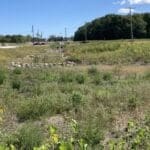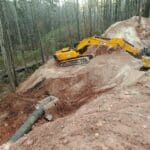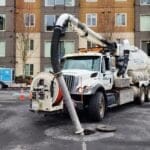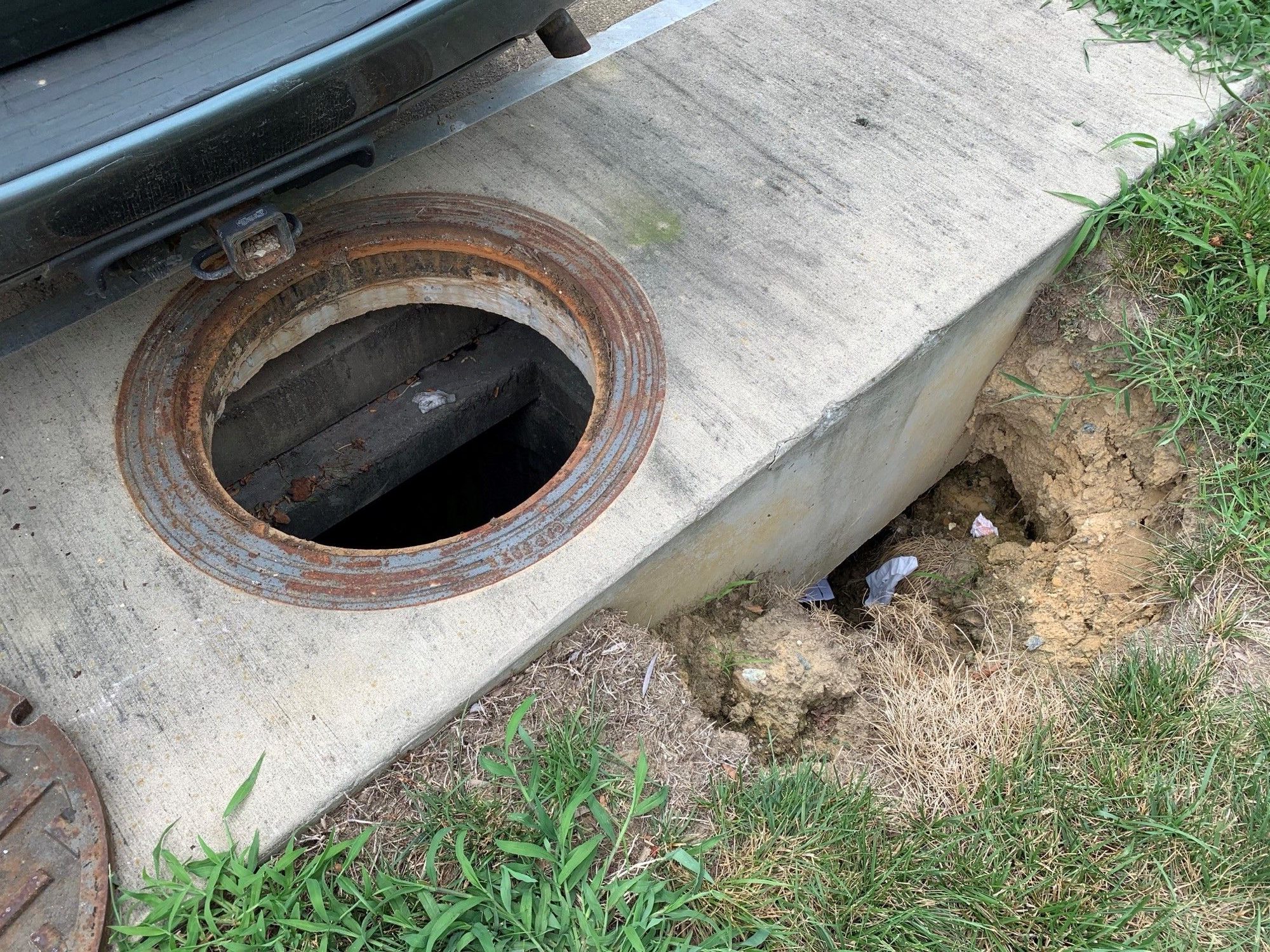Deficiency Breakdown: Sinkholes
by Jason Abert, Vice President, Service Delivery
The Hidden Dangers of Sinkholes
Sinkholes are a serious stormwater runoff threat, with damages to commercial and private property and loss of life that can result. Even seemingly small sinkholes forming in the ground surface can become a serious safety matter. AQUALIS’ stormwater professionals anticipate sinkholes throughout the country as the number of storms, heavy rain, natural hazards and rainfall increases due to the changing climate. Environmental protections are not enough to safeguard against sinkholes, we also need to prioritize the replacement of our aging infrastructure, nationwide.
Signs a Sinkhole is Forming
It is essential to understand the causes and dangers associated with sinkholes, why sinkholes form and the collapse process. In every case, identifying and reporting the sinkhole risk/deficiency early is the safest thing to do. With that in mind, it pays to know what to do if you encounter a sinkhole and understand that sinkholes can have varying root causes, resulting in the loss of soil and underlying rock underground, creating the tell-tale cavity.
What is a Sinkhole?
A good definition for sinkhole is “any naturally occurring depression in the surface of the ground from which rainfall is drained internally.” In other words, when water is allowed to flow underground (outside of pipes), it displaces soil and can create a sinkhole above ground.
What Causes a Sinkhole?
Stormwater, water and sewer lines are buried underground throughout a community along roadways and near homes and businesses. Sinkholes can be caused by structural defects involving piping or other below-ground stormwater infrastructure that has become defective, improperly installed, degraded with age or has failed. Sinkholes can occur in both older and newer properties.
Structural Failures and Sinkhole Development
A common structural failure in North America is from old, rusted-out corrugated metal pipes (CMP). CMP-type piping is no longer standard in many counties, but the legacy piping is still in place and degrading at multiple stages of its lifecycle.
Types of Sinkholes:
How do Sinkholes Form?
Sinkholes can form in several ways including:
-
- Structural defects of piping or other utility infrastructure,
- Rotting or decayed organic material like tree stumps underground,
- Improper foundations or subgrade where properties are built (example, properties built on top of abandoned dumpsites or where trees have been buried),
- From natural voids based on underground Karst features.
What are Karst Features?
Karst is described as underground layers of materials such as limestone, dolomite or gypsum that dissolve over time from water. Karst features like caves are more common in some areas than others, and those areas (like Kentucky) deal with considerably more sinkholes.
What Should You Do if You Suspect a Sinkhole is Forming?
- Contact a stormwater professional that offers underground pipe inspections to identify the root cause. If the hole is filled or crews merely cover collapsed sinkholes and the root cause is left unaddressed, the sinkhole will come back.
- Do not walk out to the edge of the hole to look and see the potential problem. Stand back a safe distance and call a professional to inspect the hole safely, to avoid a sinkhole collapse. A small hole can hide a large cavity, so think carefully about where you might step.
- If you notice a sinkhole in a roadway, parking lot, near a storm drain or another public area on your property, contact a professional immediately. Sinkholes in public areas pose a high safety risk and must be properly barricaded as quickly as possible.
AQUALIS is Experienced at Sinkhole Identification and Root Cause Analysis
If a sinkhole is suspected, AQUALIS uses several methods to determine whether failures of pipes are the cause. Geotechnical Assessment Methods include:
- Percolation testing
- Televising the line with remote-controlled cameras
- Smoke testing underground pipes
- Dye testing lines with colored dyes
- Geophysical studies or geological surveys
You are not alone in this problem. As to why sinkholes occur, aging infrastructure is a leading cause throughout the United States, on public and private property. Many communities are working to identify and repair issues that can cause sinkholes on the land surface. Sometimes, you do not know you have a problem until that little concave spot, or depression, appears after a storm, indicating an underground void. That is the first clue to look for and to investigate.
Sinkhole Repairs
Sinkhole repairs must be completed to prevent the sinkhole’s return. To stabilize the sinkhole, professionals must first divert any water away from the area. The root cause must be corrected to restore the system and prevent additional loss of subgrade soils. Then loose soils can be removed and replaced with fill material that is appropriate for the nature and severity of the opening.
Catch Basins and Sinkholes
Catch basins are a common place for damages, including sinkholes. Therefore, when onsite for routine maintenance or inspection, AQUALIS’ localized teams examine catch basins to determine if there is a possibility of a sinkhole currently or in the future, assessing function, safety and compliance.
There are three leading causes of sinking ground around catch basins:
- Subsurface issues, particularly at the riser structure
- Pipe concerns, such as the mortar breaking down around the pipe or the pipe itself becoming displaced, allowing water to get behind that area and cause soil loss that leads to a sinkhole.
- Soil compaction around the catch basin or around the pipes connecting catch basins, causing cracking in asphalt around stormwater assets.
CCTV Inspection and Catch Basin Repair
CCTV Pipe inspections are warranted when a down-pipe issue is suspected. AQUALIS’ stormwater professionals and in-house engineers work on behalf of facility managers to evaluate site plans, areas of concern and identify any possible forming sinkholes. When deployed, remote-controlled crawlers with camera attachments can document issues and track distance so the exact location of concerns can be identified.
Please contact us to learn how our highly trained professionals can assist you in protecting your property from sinkholes with preventative maintenance and repairs.
 Kenosha, Wis. Highway KR Regenerative Stormwater ConveyanceThe Root-Pike Watershed Initiative Network Kenosha County, and others worked with AQUALIS to design and implement an innovative solution for stormwater control along Highway KR.
Kenosha, Wis. Highway KR Regenerative Stormwater ConveyanceThe Root-Pike Watershed Initiative Network Kenosha County, and others worked with AQUALIS to design and implement an innovative solution for stormwater control along Highway KR. Durham, N.C. Sinkhole Leads to Stormwater System RehabilitationThe tenant on this property noticed a depression that opened to the ground below and notified the property owners.
Durham, N.C. Sinkhole Leads to Stormwater System RehabilitationThe tenant on this property noticed a depression that opened to the ground below and notified the property owners.

